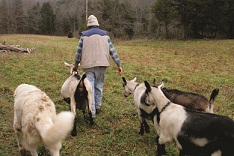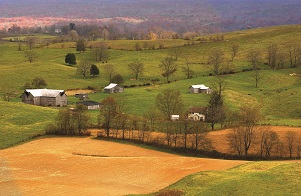 Greenbrier Valley, West Virginia, is a community with a unique perspective. While most economic development organizations focus on recruiting a broad
Greenbrier Valley, West Virginia, is a community with a unique perspective. While most economic development organizations focus on recruiting a broader range of industries, Greenbrier Valley is taking a different tact, something more like fertilizing and watering the industries that took root there naturally.
The approach is called “integrated economic development,” and the Greenbrier Valley Economic Development Corporation (GVEDC), which represents Greenbrier, Monroe and Pocahontas Counties, has made it the foundation of its program. Its approach involves analyzing the area’s inherent gifts and expanding on them to develop a better community.
Of course, Greenbrier Valley brings an unusual set of characteristics to the table. Each of its towns retains an individual character and charm, while at the same time uniting in vision and action to build an always-stronger community. Lewisburg, named the 2011 “Coolest Small Town in America” by Budget Travel magazine, offers the ideal example of what draws businesses and individuals alike to Greenbrier Valley. To quote Budget Travel, “Once in a while, you find a town that has everything …”
Its bright future and an appealing present stem from a history that runs deep throughout the Valley’s stunning mountains, valleys and rivers, nourished by an Appalachian heritage of ingenuity and creativity. It gives rise to the community’s bountiful, core industries, ones that are continuing to generate new industries and jobs today.
 Welcome to Greenbrier Valley
Welcome to Greenbrier Valley
Officially founded in 1777, Greenbrier Valley’s natural treasures played a pivotal role in the community’s development, a tradition that continues today.
Greenbrier Valley is home to America’s first organized golf course, Oakhurst Links, which was founded by a Scottish family, the Montagues, in 1884. The Valley also has welcomed legions of anglers, kayakers and canoeists, including the 2004 Olympic kayak team trials. The Allegheny Mountains provide summer and winter recreation at Snowshoe Ski Resort and travelers worldwide converge at the four-star resort, The Greenbrier, which has welcomed guests since 1778 for a taste of Greenbrier Valley’s year-round recreation and scenic splendor.
Seeds of Success
Perhaps Greenbrier Valley’s earliest settlers were drawn to its beauty, like so many of today’s visitors and new residents, but they also were drawn to its lush natural resources. Its fine woods are so renowned, in fact, that Manhattan’s Waldorf Astoria welcomes guests with Greenbrier Valley oak wood floors. Today, thanks to its vast resources and sustainable practices, West Virginia still has more than 11 million acres of hardwoods.
The area’s fertile land has given rise to more than magnificent forests, as well. Its grasslands support a thriving livestock industry and thousands of acres of bountiful soil provided the ideal foundation of the Valley’s booming agriculture industry.
The Greenbrier Valley’s key assets produced tourism, sports and recreation including a rich musical heritage, agriculture and wood products. These industries and their strong roots inspired the Valley’s unique economic development approach.
A Shining Future
Charged with fostering continued growth in Greenbrier Valley’s economic environment, GVEDC Executive Director Stephen Weir recognized that integrated economic development was the perfect fit for the community. Having over 30 years of experience, including for West Virginia Governor Caperton, Weir was prepared for developing economic strategies that played to the area’s strengths, creating self-fueling growth.
“We always have a private sector focus,” said Weir. “We are trying to create sustainable ideas and programs, industries and businesses that will feed each other as they grow. This creates a flow and exchange of private capital so we aren’t always tapping the public well.”
 Promoting the area’s local foods program is another key facet of the GVEDC’s strategy. This program was highlighted by Appalachian Regional Commission for its efforts to transform the economy by encouraging and supporting local food and entrepreneurship in Appalachia.
Promoting the area’s local foods program is another key facet of the GVEDC’s strategy. This program was highlighted by Appalachian Regional Commission for its efforts to transform the economy by encouraging and supporting local food and entrepreneurship in Appalachia.
Part of the GVEDC’s program also involves embedding an entrepreneurial development program in local middle schools, which will include a job-shadowing segment to expose students to business development and leadership skills.
Another demonstration of the program’s success is the Rahall Business and Technology Center, a 140,000 square-foot building that recently filled to capacity, welcoming new business startups ECER Technologies and the Greenbrier Valley Brewing Company.
Growing a Strong Economy
The Greenbrier Valley Local Food Initiative is an example of integrated economic development in action. With more than 300,000 acres available — without cutting down any trees — Greenbrier Valley has one of the region’s scarcest agricultural resources: fertile, and available, land.
“Six years ago,” explained Weir, “I was approached by a number of local food leaders who suggested that we consider adopting agriculture as part of our economic development plan. We agreed, but only if we would treat agriculture much as we would manufacturing or any other traditional business segment. We could then assess how successful local farms practiced their trade and then target resource development that would help them expand their markets.”
Greenbrier Valley’s local food industry is supported through a number of strategies:
The Greenbrier Valley Local Foods Initiative (GVLFI), a GVEDC project that provides technical assistance and training for food and farm entrepreneurs (along with the Value Chain Cluster Initiative), recently launched the Greenbrier Valley Grown™ brand, and is exploring the feasibility of a processing, aggregation and distribution facility for area farmers.
Ongoing collaboration between mainstream economic development institutions and grassroots organizations.
GVEDC-provided office space for startup groups.
Greenbrier Valley’s local food industry primarily produces grass-fed beef, as well as turkey, pork, lamb, chicken and produce. Not only does the industry generate income for farmers, but also, thanks to the work of the GVLFI, it has given rise to a distribution network, a range of local-sourcing restaurants and a reputation for exceptional dining that contributes to the Valley’s tourism industry. What’s more, the Valley’s agriculture industry is contributing to the world at large: Purple Mountain Phoinix Farm, for example, specializes in preserving rare and endangered chicken breeds.
Embracing its Scottish ancestry, Greenbrier Valley also is introducing a project called “Sharecrofting.” Based on Scottish Highlands “croft” farming, the initiative will enable beginning farmers by providing affordable land, communal resources, equipment and experienced mentors.
 In the spirit of integrated economic development, the GVEDC also is focusing on several initiatives to develop the area’s wood products market. Not only is the Valley rich in wood resources and experienced craftspeople, but also the wood products industry has a readymade market: it creates many products necessary for the agriculture segment.
In the spirit of integrated economic development, the GVEDC also is focusing on several initiatives to develop the area’s wood products market. Not only is the Valley rich in wood resources and experienced craftspeople, but also the wood products industry has a readymade market: it creates many products necessary for the agriculture segment.
“We’re focusing on helping craftspeople create old, time-proven crafts, but with new technology,” said Weir. “By creating efficiencies, we hope to expand the market.”
The community is planning a new industrial park on the I-64 exchange at Sam Black Church to support this market.
The Sky’s the Limit
A vibrant high-end electronics sector is another of the Greenbrier Valley’s local industries. Appalachian Electronic Instruments, an industrial instrumentation producer, attributes the area’s proliferation of advanced technology to the innovative Appalachian culture, saying, on its website: “The strength of this Appalachian culture inspired other instrument makers to locate in this same region. So many significant technologies were developed in this locality that it became known as a ‘cradle’ of the instrumentation industry.”
To that point, companies like United Technologies and Greenbrier Communications are also developing industry-leading technologies in Greenbrier Valley. In addition to Appalachian innovation, though, Greenbrier Valley also delivers a strategically sound location, with I-64 running right through the county.
Aviation is another one of the area’s growing industries, with the state’s longest runway and a strong aviation presence, including TransCon, a leading aviation training company.
Fuel for Growth
Education has long been a vital part of Greenbrier Valley’s core. Founded in 1812, Lewisburg Academy was one of the country’s more progressive educational institutions because it served both men and women equally. Today, colleges and universities abound throughout West Virginia, providing easy access to advanced training and an educated workforce. The New River Community and Technical College Greenbrier Valley Campus and The West Virginia School of Osteopathic Medicine (WVSOM) are just a couple of examples of higher education opportunities located right in Greenbrier Valley.
“The biggest proof is in the past,” said Weir. “Look at the industries in Greenbrier Valley that have grown and continued growing, despite the recent economic downturn nationwide. When you’re coming off a five- to eight-year period of depressed business growth throughout the country, and you see that we’ve remained strong, it’s a testament to the resources and resilience of the Greenbrier Valley.”


There are no comments
Please login to post comments